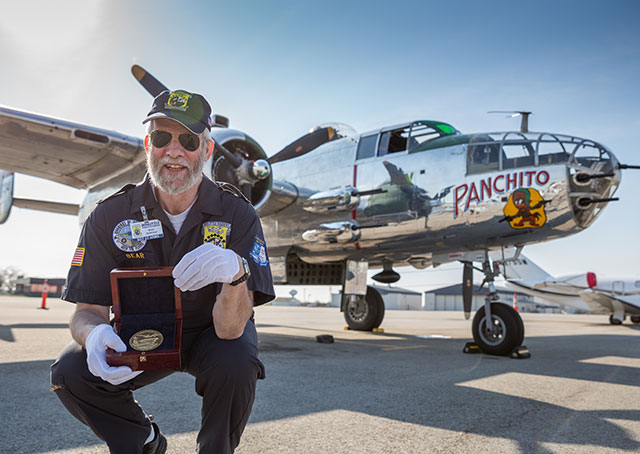Doolittle Raiders celebrate honor, say goodbye to friends
Congressional Gold Medal awarded April 15

It took 72 years, 11 months, 28 days, and an act of Congress, but the Doolittle Tokyo Raiders finally received the Congressional Gold Medal for their heroic raid bombing Japan’s mainland on April 18, 1942.
Of the 80 men who launched from the USS Hornet in 16 North American B-25 Mitchell bombers in the Pacific Ocean, only two men, Lt. Col. Richard E. Cole and Staff Sgt. David J. Thatcher, remained living to see the honor. Cole and Thatcher were on hand April 18, the seventy-third anniversary of the raid, when the B-25 Panchito overflew Wright-Patterson Air Force Base in Dayton, Ohio, at 11 a.m., carrying the Congressional Gold Medal and dignitaries including Don Penny Schneider, a personal friend of Jimmy Doolittle. (According to Larry Kelley, owner and pilot of Panchito, Schneider donned the watch that Doolittle’s mother-in-law had given him in 1939, which he wore on the raid and into the 1970s before giving it to Schneider.) The 11 a.m. flyover was timed to coincide with the raid, Kelley said. After Panchito landed, two firetrucks created a water cannon for the B-25 to taxi through on its way to Cole and Thatcher.
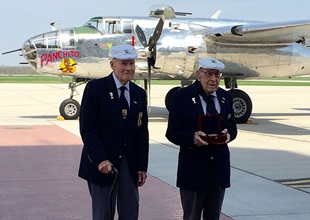
Brian “Bear” Anderson, the Doolittle Tokyo Raiders Association sergeant at arms who had spent years building support for the Raiders to be recognized with the Congressional Gold Medal, walked from Panchito to present the medal to Cole and Thatcher. “Gentlemen, it’s a pleasure to be able to present you with this Congressional Gold Medal for the Doolittle Tokyo Raiders,” he said.
Anderson received support from Sen. Sherrod Brown (D-Ohio) and Rep. Pete Olson (R-Texas), who introduced the legislation to honor the Raiders with the Congressional Gold Medal. Anderson said he personally visited the office of every senator and representative on Capitol Hill to build support for the legislation, watched as President Barack Obama signed the bill into law, helped to design the medal, was in Washington, D.C., for the Congressional celebration, and culminated his efforts by personally presenting the medal to the Doolittle Tokyo Raiders in Ohio.
The actual awarding of the Congressional Gold Medal took place a few days earlier, April 15, during a ceremony at Emancipation Hall in the U.S. Capitol. John Hudson, director of the National Museum of the U.S. Air Force, accepted the medal on behalf of the Raiders. Cole and Thatcher did not attend the ceremony in Washington, D.C., but Cole provided a video address. (Cole was on hand in May 2014 when President Barack Obama signed the bill into law.) The Doolittle Tokyo Raiders donated the medal to the museum, where it is now part of the Raiders display.
‘First strike’
The raid was the United States’ answer to Japan’s attack on Pearl Harbor. The successful bombing of Japan’s mainland not only boosted Americans’ morale but shook the confidence of the Japanese, leading to the U.S. victory at the Battle of Midway, which is often credited as the turning point of World War II in the Pacific. (See “Secret Mission.”) “They were the movers and the shakers” behind Japan’s change in strategy at Midway, Anderson said of the Doolittle Tokyo Raiders. Because of that, he wanted to ensure that the medal encompassed several aspects of the raid.
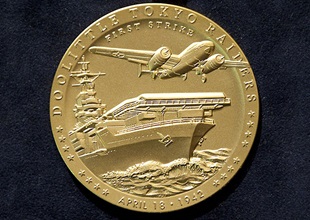
The medal features the first B-25 flying off the USS Hornet, with the words “First Strike” arched above. The outline includes “Doolittle Tokyo Raiders,” the date of the attack, and 16 stars that represent the number of B-25 crews that participated in the raid. The back features three B-25s; the group’s motto, “Toujours Au Danger”; patches of each of the four squadrons that participated; and an outline of Japan.
“It’s beautiful, a good representation of the group,” Cole said.
Thatcher said, “I’m glad it was for the entire crew,” adding that the medal included “important information on both sides of it.”
“We tried to cover the essence of what you were all about that day,” Anderson said to Cole and Thatcher.
Remembering the day, and their comrades
During various events at the celebration in Dayton, friends, family members, and supporters of the Doolittle Tokyo Raiders reflected on what happened on the same day 73 years earlier, about those who have since died, and about preserving their legacy.
According to Kelley, Cole reminisced about the raid during a ceremony at the National Museum of the U.S. Air Force. When Cole, 99, walked up to the podium, Kelley said, he reminded the audience that 73 years ago, he was hanging from a tree by his parachute and that Thatcher was helping injured crewmembers after his aircraft ditched.
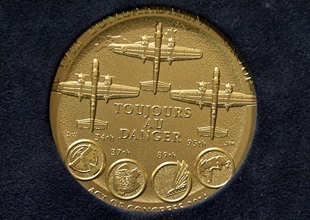
Cole, a co-pilot for Doolittle, told the Air Force media that “the B-25 was state of the art in my time” and that his main thought the day of the raid was to keep Doolittle happy; Cole added that he must have succeeded because “he [Doolittle] didn’t fire me.”
“We were also a little bit scared because it was the first time any of us had been in combat. The only thing that crossed our mind was that we were worried about the fighters,” Cole said. “Fortunately, we weren’t jumped or anything. We just stayed the course and were fortunate enough to make it and go on to China.”
Thatcher was an engineer-gunner on Crew No. 7, which ditched off the coast of China, injuring the crew. “I had a bird’s eye view, I was in the turret on top,” Thatcher recalled, adding that he could “see every direction.” The biggest challenge, he said, was that they weren’t prepared with supplies for the injuries they sustained during the ditching.
In a private ceremony, Thatcher and Cole had a toast of Hennessy cognac in memory of Lt. Cols. Edward J. Saylor and Robert L. Hite, who died earlier this year.
Preserving the legacy
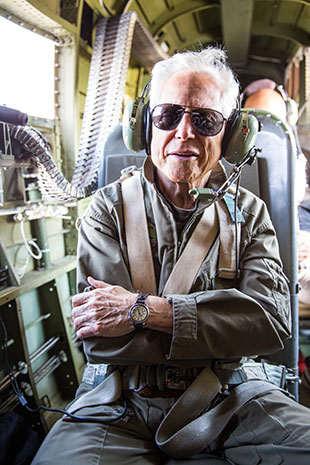
While Anderson was pounding the pavement Capitol Hill, visiting lawmakers’ offices to get them to support the bills for the Congressional Gold Medal, he was thinking of preserving the legacy of the Doolittle Tokyo Raiders.
“It’s all about the legacy,” he said, explaining that future generations need to understand the sacrifices these men made to boost the morale of Americans after the bombing of Pearl Harbor.
“Well, now the boys will be recognized,” Anderson told AOPA.
Kelley also works to ensure younger generations learn about the heroic efforts of these men, and said that each time he participates in a flight that honors the Doolittle Tokyo Raiders, “it seems to be the pinnacle of my flying career.” Kelley has played a vital role in honoring the Raiders with B-25 flyovers, including the sixty-eighth and seventieth anniversary reunions of the raid, a five-ship missing man formation for the Raiders’ final toast, and transporting the Congressional Gold Medal.
“We do anything we can to salute these guys and other veterans,” Kelley said.
Perhaps the most tangible way the Doolittle Tokyo Raiders’ legacy will touch future generations is through a scholarship that the Hennessy family is funding in perpetuity. The Doolittle Tokyo Raiders toast with Hennessy cognac in remembrance of their comrades who have died, and the family has been donating $10,000 each year since the Raiders’ seventy-first reunion for a scholarship for young people seeking a career in aviation.
